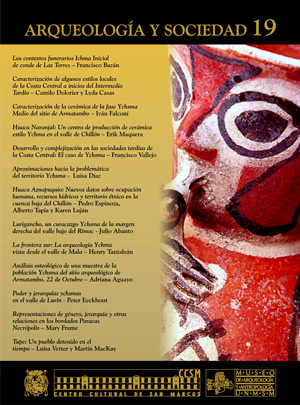POWER AND HIERARCHIES YCHSMAS IN THE VALLEY OF LURIN
DOI:
https://doi.org/10.15381/arqueolsoc.2008n19.e12705Keywords:
Pachacamac, Ychsma, Lurín, Archaeology, Ethnohistory.Abstract
The definition of the form of authority that was dominating the Lurín and neighboring valleys during the late periods continues being an object of debate. Ethnohistorical sources have been massively used to reconstruct the socio-political regional framework before the Incas. Though certain authors defend a model of theocratic power dominated by the priests of Ychsma-Pachacamac’s cult, others propose a division of the authority between priests and curacas, i.e. between religious and secular. Monumental architecture and settlement patterns provide interesting information to feed this debate. Concretely, I compare this set of archaeological data with the information gathered in the Lurín valley before the reforms of Toledo. It confirms the importance of curacas, their subdivisions and hierarchies, and the absence of link with the religious sphere, but rather with the most secular aspects of power (territory and tribute). The comparison allows to reconstruct the flowchart of power in the zone and to see how it was materialized in the field, so much for the design of the architectural structures as for the relative size of the social groups involved in different levels of power, and their probable evolution through time.Downloads
Published
Issue
Section
License
Copyright (c) 2008 Peter Eeckhout

This work is licensed under a Creative Commons Attribution-NonCommercial-ShareAlike 4.0 International License.
THE AUTHORS RETAIN THEIR RIGHTS:
a. The authors retain their trademark and patent rights, and also on any process or procedure described in the article.
b. The authors retain the right to share, copy, distribute, perform and publicly communicate the article published in the Arqueología y Sociedad (for example, place it in an institutional repository or publish it in a book), with an acknowledgment of its initial publication in the Arqueología y Sociedad.
c. The authors retain the right to make a subsequent publication of their work, to use the article or any part of it (for example: a compilation of their works, notes for conferences, thesis, or for a book), provided that they indicate the source. of publication (authors of the work, journal, volume, number and date).






